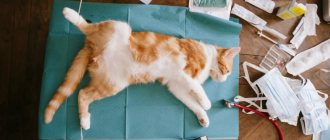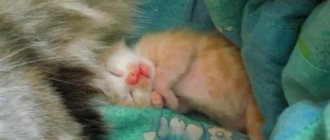Cat pregnancy is the period from conception to birth and is a significant and responsible part of the animal’s life. Its owner must carefully care for the cat and take care of its well-being.
The gestation period in cats will help you find out the estimated due date. Each cat's pregnancy progresses differently; birth may be premature or, conversely, delayed.
The length of pregnancy depends on several factors - the number of kittens being carried, the individuality of her body and age. The average period of normal pregnancy for a cat is 64-67 days (about 9 weeks).
How to understand that a cat is waiting for a replenishment
If it so happens that there was a mating or you simply suspect your cat that she has become an adult, and now you need to find out if the cat is pregnant, there are several signs:
- The surest way to find out if a cat is expecting kittens is to examine her mammary glands. They will swell greatly. This is especially observed during the cat’s first pregnancy. This may not be noticeable to you unless you deliberately look at your cat's nipples, but this is unlikely as they will at least become larger and redder. This should alert you.
- The cat seems lethargic and tired. If you notice that your pet has become somewhat apathetic and doesn’t want to play or run at all, especially if she loves to do this so much.
- Toxicosis is a common sign of pregnancy in many creatures, cats are no exception. In the early stages, it constantly appears and is accompanied by nervousness and poor appetite. Fortunately, although this may cause your pet to lose weight, it is completely safe for her. The only thing is that you need to carefully watch to ensure that diarrhea and dehydration do not appear. If this happens, take your cat to the vet immediately.
- Frequent trips to the toilet are also a symptom of pregnancy. During pregnancy, cats generally begin to empty their bladder more often. This is normal and you shouldn’t worry, the most important thing is to check what color the urine is: if it’s light, then everything is fine, if you see mixed blood, go to the veterinary clinic.
Preparing for lambing
The owner can learn that the moment of lambing is approaching by the behavior of the pet: the cat intensively licks itself and begins to look for a cozy, suitable place for giving birth. For this purpose, you should prepare a clean, spacious box in advance and make a hole for a manhole on one of the walls. Clean towels or sheets are placed in the box and changed as needed. The box is covered with a lid on top to ensure optimal temperature conditions for future offspring. It is recommended to locate this structure in a quiet, dry, dark place, and keep it perfectly clean.
It also does not hurt the owners to stock up on the minimum necessary list of medications and auxiliary materials, namely:
- disinfectant (alcohol or hydrogen peroxide will do);
- clean diapers;
- scissors;
- special sterile wipes;
- brilliant green (needed when processing the umbilical cord);
- cotton threads for tying the umbilical cord;
- veterinarian contacts.
An additional list of medications can also be clarified by visiting a veterinary clinic in advance.
How long does pregnancy take?
On average, pregnancy in cats lasts about 9 weeks – 2 months.
- The timing can vary depending on several factors: the breed of the cat decides a lot, for example, in Siamese and Orietals, pregnancy is often prolonged and can last more than 9 weeks, and also how many kittens are in the litter, the more, the faster the cat will give birth.
- In Scottish Fold and British cats, pregnancy also lasts a long time - from 63-67 days. By the standards of cats, this is a fairly long gestation period.
If you plan to breed the breed, you need to very carefully monitor the number of pregnancies per year so that the cat’s health is normal and the kittens are healthy.
Since pregnancy is always a big stress for any body. Many veterinarians believe, for example, that the optimal number of pregnancies per year can be considered only one. More than one pregnancy per year is too traumatic.
How to care for a pregnant cat
Pregnancy in a cat, especially the first, can cause anxiety in owners. And that's okay. But try not to show your excessive concern about this issue, because cats in general, and during pregnancy, are especially sensitive and very sensitive to mood swings and the excitement of others.
And your pet doesn’t need any extra stress at all. Just provide her with good nutrition with all the necessary substances and elements, give her more water. Try to keep the litter box clean at all times, because when your cat is pregnant this is more important than ever.
Also give your pet more attention and love. And before she has to give birth, make a place for her where she will bear offspring. It should be quite secluded and calm.
Childbirth
How can you tell if your cat is about to give birth?
There are several exact signs, they are very similar to those that occur during the onset of pregnancy:
- She will start to worry, stop eating or start eating very little, start washing her face very often, and start breathing more frequently.
- You definitely cannot ignore the last sign.
- Next, the cat will begin to build a nest for birth, if you have not provided one for her in advance.
Sometimes it may be that even if she has received the birthing area in advance and has fully accepted it, the cat may still drag some of your things there to make it cozier. After the beautification of the nest is completed, the cat will wait, lying in it, without moving from its place.
Most often, cats cope on their own and do not need help with childbirth. In principle, they do not really like attention during this period; they need peace and quiet. Therefore, most often cats give birth while no one is home or at night.
But if it happens that the cat screams or bleeding starts and the kittens do not appear, you need to urgently call a doctor. And it doesn’t matter at all if the cat has given birth many times before.
After everything is over and the kittens appear, the cat may not eat for about a day. Don't worry. The most important thing is that there is water and the cat has access to it.
Features of the first mating
During the first heat, it is advisable to isolate a teenage cat from contact with the opposite sex. This must be monitored especially carefully if she has free access to the street, which most often happens in private houses. Before the body is fully formed, any pregnancy should be excluded. Kittens born to a young mother have health problems. The life of the cat itself is jeopardized by early birth. Therefore, for the well-being of her and future kittens, it is advisable to pair her with a male cat after the second or third heat.
Representatives of some breeds are bred for the first time at one and a half years old. Before this, you need to show the cat to the veterinarian . It will determine how mature the pet’s body is to bear healthy offspring. It may be necessary to compensate for the lack of vitamins and microelements before the impending pregnancy. All necessary vaccinations must be completed. Also, if necessary, the veterinary clinic will treat your cat for diseases and parasites. Prescribed drugs cannot be taken during pregnancy, so all treatment is carried out before the expected event.
How to care for newborns
First of all, you need to understand that a cat can mate on its own. On the contrary, it is better not to even hold the kittens again.
If there is something wrong with the cat, there is no milk or it has disappeared, in this case you can take care of the newborns and start feeding them. But not more.
The rest is up to the cat. After all, her instinct will be aimed at being a mother and protecting her offspring.
Estrus during gestation
There are cases of estrus occurring during pregnancy. This occurs in one in ten cats. Most often this happens at 3-6 weeks. If at this time there was mating with a male, then secondary conception occurs. The newly fertilized egg is implanted in the uterus. Embryos also develop from it. At birth, these offspring turn out to be premature compared to those already formed. In most cases it dies. Kittens of the second conception sometimes remain in the uterus and may be born a week after the first.











